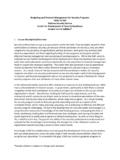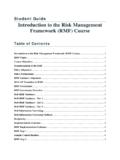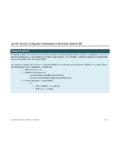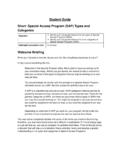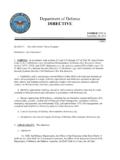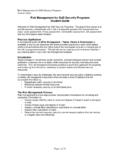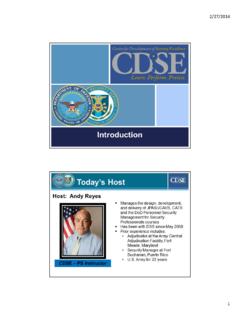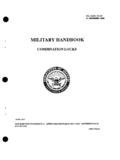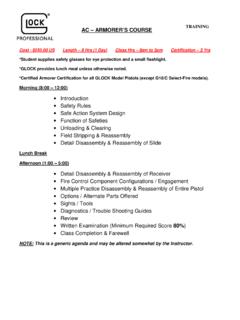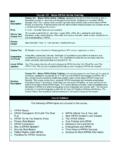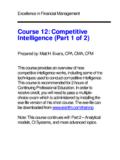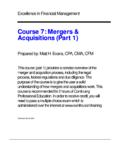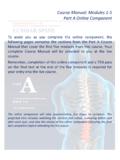Transcription of SAMPLE COURSE SYLLABUS* 1 Course …
1 * SAMPLE syllabus is subject to change each semester. Cybersecurity and Oversight of Information System Security (CDSE ED 514) Defense Security Service (DSS) Center for Development of Security Excellence (CDSE) Education Division SAMPLE COURSE SYLLABUS* 1 COURSE Description/Overview The ability to secure information within a modern enterprise large or small is a growing challenge. Threats to information security are global, persistent, and increasingly sophisticated. Long gone are the days when managers could hope to secure the enterprise through ad hoc means. Effective information security at the enterprise level requires participation, planning, and practice. It is an ongoing effort that requires management and staff to work together from the same script.
2 Fortunately, the information security community has developed a variety of resources, methods, and best practices to help modern enterprises address the challenge. Unfortunately, employing these tools demands a high degree of commitment, understanding, and skill attributes that must be sustained through constant awareness and training. It is important to note as well that effective security is not achieved in stovepipes. Ineffective physical security, for example, can undermine otherwise effective information system security, and vice versa. Effective security at the enterprise level requires the effective interaction of physical security, information security, personnel security, and so on indeed, all branches of security must interact effectively as a system to achieve overall enterprise security.
3 This COURSE is designed to teach mid-level security practitioners how to engage all functional levels within the enterprise to deliver information system security. To this end, the COURSE addresses a range of topics, each of which is vital to securing the modern enterprise. These topics include inter alia plans and policies, enterprise roles, security metrics, risk management, standards and regulations, physical security, and business continuity. Each piece of the puzzle must be in place for the enterprise to achieve its security goals; adversaries will invariably find and exploit weak links. Additionally, the Department of Defense (DoD) is itself a massive enterprise, and security practitioners should understand the context and importance of their activities within the overall DoD enterprise.
4 To this end, the COURSE will emphasize the practical implications of cybersecurity management to DoD roles and missions through the application and study of timely examples. 2 Target Audience/Prerequisites This COURSE is intended for DoD civilian and military personnel who perform security leadership and management duties. All students will be required to have achieved the Security Fundamentals Professional Certification (SFPC) under the DoD Security Professional Education Development Program (SP D) or to have comparable fundamental knowledge of DoD security programs. 3 Student Outcomes/Objectives At the end of this COURSE , students will be expected to be able to: Assess the current security landscape, including the nature of the threat, the general status of common vulnerabilities, and the likely consequences of security failures; Critique and assess the strengths and weaknesses of general cybersecurity models, including the CIA triad; Appraise the interrelationships among elements that comprise a modern security system, including hardware, software, policies, and people; Assess how all domains of security interact to achieve effective system-wide security at the enterprise level.
5 Compare the interrelationships among security roles and responsibilities in a modern information-driven enterprise to include interrelationships across security domains (IT, physical, classification, personnel, and so on); Assess the role of strategy and policy in determining the success of information security; Estimate the possible consequences of misaligning enterprise strategy, security policy, and security plans; Design a notional information security plan that incorporates relevant principles of lifecycle management; Evaluate the principles of risk and conduct a notional risk management exercise; Assess the role of good metrics and key performance indicators (KPIs) in security assessment and governance; Create a good set of information security metrics; Critique the current legal and regulatory environment as it applies to cybersecurity; Identify and contrast the most common security standards and associated catalogues of security controls; Contrast the various approaches to security training and formulate a simple training agenda; Justify the need for business continuity planning and propose how to implement such a plan successfully within a modern enterprise; Compare and contrast logical and physical security.
6 Appraise the current structure of cybersecurity roles across the DoD enterprise, including the roles and responsibilities of the relevant organizations; Assess the strengths and weaknesses of the certification and accreditation approach to cybersecurity; Evaluate the trends and patterns that will determine the future state of cybersecurity. 4 Delivery Method This is a graduate-level distance-learning COURSE in assessing current and future security functions, technologies, and systems relevant to DoD programs. The COURSE will consist of readings, lectures and presentations, asynchronous sessions, participation in the discussion forum, graded research papers, and three quizzes. Because this is a 3 credit hour equivalent COURSE , the contact time over the 16 weeks should be approximately 30 hours.
7 A typical week will include a 45 60 minute lecture or equivalent presentation with notes and comments; the lecture or presentation will be followed by either a quiz (about one hour duration to complete), an alternative assignment, or an on-line discussion forum. Generally a discussion will be based on instructor-provided discussion question(s) with each student providing a response and then commenting on other student inputs. This discussion format will constitute the remainder of the contact time for each lesson (for eight lessons). Students should be prepared to discuss and debate the readings as well as examine and assess them for biases and multiple perspectives. Students should also be investigating how other disciplines relate to the readings and be prepared to discuss this aspect.
8 The assigned COURSE readings will draw from a variety of resources, such as authoritative readings (legislation, executive orders, policies, plans and strategies, and journals), implementation readings (government products that are responsive to or attempt to fulfill the requirements of authoritative documents), and external reviews (from the Government Accountability Office, Congressional Research Service, or other agency or office). Students will be provided with a large number of open access and password protected sites yielding a tremendous number of peer-reviewed research assets. Students will also be expected to monitor and interpret current information security news and will be provided with links to news stories and events during the COURSE .
9 These will help support the structured online discussions. Students will be expected to do research at the graduate level in this COURSE . To provide a substantial research capability to all students in the program, a number of internet-accessible research sites will be sent to each student prior to the first lesson. Students will also receive information for signing on to approximately a dozen other research sites or databases relevant to security and defense studies; one example would be opening an account with the Defense Technical Information Center (DTIC). This will ensure that every student has more than enough resources to do the research expected in this COURSE . The instructor may provide additional research sources or sites.
10 Students are also encouraged to make use of library and research sources available to them in their own geographical area or through their own professional or academic networks (such as the Pentagon and NDU libraries). 5 General COURSE Requirements Class participation is both important and required. If, due to an emergency, students are not able to respond to a discussion promptly in the week it is assigned, they must contact the instructor by e-mail and will be expected to post their response in the following week. Weekly assignments must be posted in the Sakai CLE by 2359 EST on the day they are due. It is expected that assignments will be submitted on time; however, it is recognized that students occasionally have serious problems that prevent work completion.
